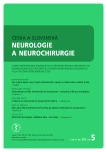Can Intracranial Venous Reflux Be Detected from Transcondylar Approach? The Results of a Fusion Imaging Study
Authors:
D. Školoudík 1,2; M. Kuliha 1; M. Roubec 1; J. Havelka 3; F. Formagnana 4; L. Forzoni 4; R. Herzig 2
Authors‘ workplace:
Neurologická klinika FN Ostrava
1; Neurologická klinika LF UP a FN Olomouc
2; Ústav radiodiagnostický FN Ostrava
3; ESAOTE, Firenze, Italy
4
Published in:
Cesk Slov Neurol N 2012; 75/108(5): 611-616
Category:
Short Communication
Overview
Introduction:
Transcondylar approach is a new approach used for detection of chronic cerebro-spinal venous insufficiency (CCSVI) and venous reflux in intracranial venous system in patients with multiple sclerosis. The aim of the study was to assess suitability of the transcondylar approach for monitoring blood flow through the deep cerebral veins and venous sinuses.
Material and methods:
Brain magnetic resonance imaging and transcranial duplex sonography (TCCS) from transtemporal and transcondylar approaches using the new technology – Fusion Imaging – were performed in six volunteers and five patients with multiple sclerosis.
Results:
In all subjects, the root mean square error was <0.5 cm and the accuracy of the system, measured using a registration pen, was <1 mm. In all subjects, all arteries of the circle of Willis, deep middle cerebral vein, basal vein of Rosenthal, superior and inferior petrosal sinuses, cavernous and transversal sinuses and confluens sinuum were visible from transtemporal approach. However, transcondylar approach enabled depiction of the internal carotid artery siphon in three (27.3%) and middle cerebral artery in one (9%) subject only. Blood flow signal from cavernous, inferior or superior petrosal sinuses and deep brain veins was not detected in any subject even when the Fusion Imaging was used. Bidirectional Doppler signal from the cavernous sinus region was evaluated as an artefact.
Conclusion:
The study results showed that TCCS transcondylar approach is not suitable for standard detection of intracranial venous reflux.
Key words:
ultrasound – magnetic resonance imaging – reflux – venous system – fusion imaging
Sources
1. Školoudík D. Transkraniální barevná duplexní sonografie. In: Školoudík D, Škoda O, Bar M, Václavík D, Brozman M (eds). Neurosonologie. Praha: Galén 2003: 181–250.
2. Skoloudík D, Walter U. Method and validity of transcranial sonography in movement disorders. Int Rev Neurobiol 2010; 90: 7–34.
3. De Beni S, Macciò M, Bertora F. Multimodality Navigation Tool “Navigator”. Proc. IEEE SICE 2nd International Symposium on Measurement, Analysis and Modeling of Human Functions. Genova, Italy 2004.
4. D’haeseleer M, Cambron M, Vanopdenbosch L, De Keyser J. Vascular aspects of multiple sclerosis. Lance Neurol 2011; 10(7): 657–666.
5. Laganà MM, Forzoni L, Viotti S, De Beni S, Baselli G, Cecconi P. Assessment of the cerebral venous system from the transcondylar ultrasound window using virtual navigator technology and MRI. Proc. 33rd Annual International Conference of the IEEE EMBS. Boston, Massachusetts, USA 2011.
6. Zamboni P, Menegatti E, Galeotti R, Malagoni AM, Tacconi G, Dall‘Ara S e tal. The value of cerebral Doppler venous haemodynamics in the assessment of multiple sclerosis. J Neurol Sci 2009: 282(1–2): 21–27.
7. Nosáľ V, Sivák Š, Kurča E. Chronická cerebrospinálna venózna insuficiencia (CCSVI). Metodický postup vyšetrenia venózneho systému pomocou ultrazvuku. Neurológia 2010; 5(3): 163–167.
8. Zamboni P, Menegatti E, Bartolomei I, Galeotti R, Malagoni AM, Tacconi G et al. Intracranial venous haemodynamics in multiple sclerosis. Curr Neurovasc Res 2007; 4(4): 252–258.
9. Zamboni P, Galeotti R. The chronic cerebrospinal venous insufficiency syndrome. Phlebology 2010; 25(6): 269–279.
10. Nosáľ V, Zeleňák K, Michalik J, Kantorová E, Sivák Š, Kurča E. Chronická cerebrospinálna venózna insuficiencia. Neurológia 2010; 5(3): 158–162.
11. Bartels E. Color-coded duplex sonography of the cerebral vessels: atlas and manual. Stuttgart-New York: Schattauer 1999.
12. Berg D, Godau J, Walter U. Transcranial sonography in movement disorders. Lancet Neurol 2008; 7(11): 1044–1055.
Labels
Paediatric neurology Neurosurgery NeurologyArticle was published in
Czech and Slovak Neurology and Neurosurgery

2012 Issue 5
- Metamizole vs. Tramadol in Postoperative Analgesia
- Memantine in Dementia Therapy – Current Findings and Possible Future Applications
- Memantine Eases Daily Life for Patients and Caregivers
- Metamizole at a Glance and in Practice – Effective Non-Opioid Analgesic for All Ages
- Advances in the Treatment of Myasthenia Gravis on the Horizon
Most read in this issue
- Motor Stereotypies in Childhood – Case Reports
- Emotional Memory – Pathophysiology and Clinical Associations
- Neurological Complications Associated with Assisted Reproductive Technology – a Case Report
- Cerebrospinal Fluid Triplet in the Diagnosis of Alzheimer-Fischer disease
